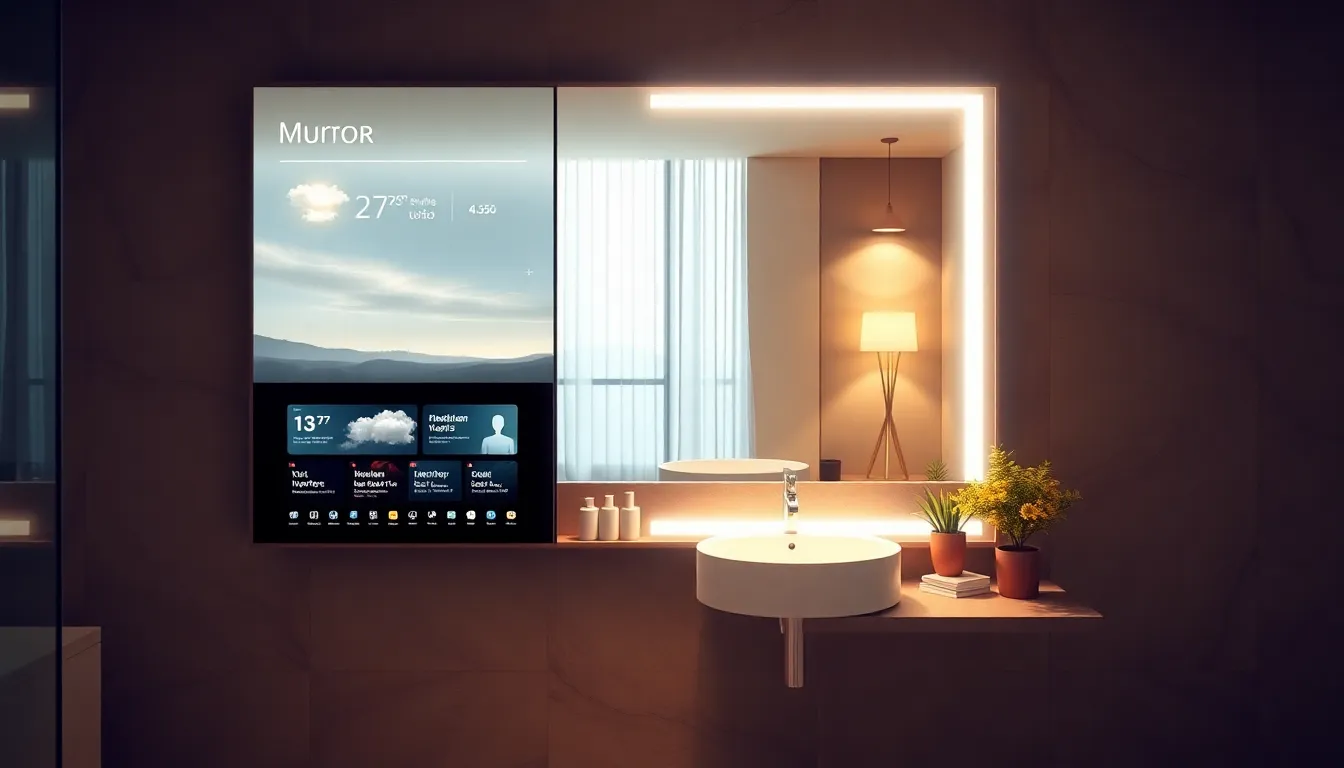Table of Contents
ToggleImagine stepping into your bathroom and being greeted by a mirror that not only reflects your fabulous self but also offers the latest news, weather updates, and even your morning motivational quotes. Welcome to the world of smart mirror technology—where vanity meets innovation.
These high-tech mirrors are transforming mundane routines into interactive experiences. Gone are the days of just checking your hair; now you can check your calendar, stream music, and even monitor your skincare routine—all while perfecting that bedhead look. It’s like having a personal assistant who never judges your choice of pajamas.
As smart homes become the norm, smart mirrors are leading the charge, blending functionality with style. So, get ready to embrace the future of reflection—because who wouldn’t want a little tech magic in their daily grooming routine?
Overview of Smart Mirror Technology
Smart mirror technology has revolutionized traditional mirrors into multifunctional devices. These devices combine reflective glass with interactive digital displays, offering more than mere reflections. Users benefit from a wealth of information, including real-time news updates and local weather forecasts.
Integration of smart mirror technology into daily routines enhances personal care and efficiency. While getting ready, individuals can check their calendars and set reminders, making multitasking seamless. Streaming music or following video tutorials adds entertainment to morning routines, transforming the mundane into engaging experiences.
Manufacturers equip smart mirrors with touch screens and voice recognition technology. Enhanced features allow users to control home automation systems through voice commands. For example, adjusting lighting or temperature becomes effortless while preparing for the day.
Security also plays a key role in the functionality of smart mirrors. Many models sync with security systems, providing notifications about a home’s status. This feature ensures peace of mind, especially for busy individuals.
As smart homes continue trending, smart mirrors emerge as stylish additions. Design elements blend aesthetic appeal with utility. From minimalist styles to high-tech customizations, these mirrors adapt to various interior designs, enhancing overall home decor.
Smart mirror technology elevates daily routines by merging reflective surfaces with digital capabilities, making them essential components in smart homes and personal spaces.
Features of Smart Mirrors

Smart mirrors offer users a blend of technology and convenience, enhancing both functionality and aesthetics in everyday routines.
Display Capabilities
The display capabilities of smart mirrors set them apart from traditional mirrors. They provide high-definition screens that showcase relevant information, such as news headlines, weather updates, and calendar events. Many models leverage touchscreen technology, allowing users to interact directly with the display. Some mirrors even include augmented reality features, enabling virtual try-ons of makeup. These visual enhancements empower users with real-time information while they prepare for the day, making routines more efficient.
Interactive Functionality
Interactive functionality drives the appeal of smart mirrors. Users can control the mirror through touch gestures or voice commands, streamlining tasks like setting reminders or playing music. Many mirrors support multimedia playback, including video tutorials and podcasts, which can be particularly useful for grooming routines. With built-in sensors, some smart mirrors adjust brightness and color temperature automatically according to ambient light. This customizability makes daily rituals more enjoyable and personalized.
Integration with Smart Home Devices
Smart mirrors seamlessly integrate with other smart home devices, enhancing overall home management. Users can connect their mirrors to smart speakers, lights, and security systems, allowing centralized control from a single interface. For example, voice commands can adjust lighting in a bathroom or provide security alerts. This connectivity contributes to a cohesive smart home experience, where users benefit from convenience, safety, and efficiency. Integration capabilities position smart mirrors as essential components of modern homes.
Applications of Smart Mirrors
Smart mirrors serve multiple purposes, offering value across various sectors. From health and fitness to marketing, their applications enhance user experiences.
Health and Fitness
Users track their wellness goals with smart mirrors, making their fitness journeys more interactive. These mirrors often feature integrated workout tutorials and real-time metrics. They guide users through exercises while providing performance feedback. Some smart mirrors even allow users to connect with personal trainers for virtual sessions. As a result, tracking progress becomes seamless and motivating.
Home Automation
Home automation receives a boost through smart mirrors. They control lighting, security systems, and temperature settings with simple voice commands. Users can check the status of their homes while getting ready. These smart devices also integrate with other home gadgets, creating a centralized hub for management. Enhanced convenience emerges as users can execute numerous functions without additional devices.
Retail and Marketing
Retail settings utilize smart mirrors to enhance customer engagement. Virtual try-on features allow shoppers to see how products look without physical application. Brands can personalize shopping experiences by showcasing targeted promotions or recommendations. Many retailers leverage smart mirrors to collect data on customer preferences, improving inventory and service. This technology transforms the shopping process into an interactive experience, driving sales and customer satisfaction.
Advantages of Smart Mirror Technology
Smart mirror technology offers numerous benefits that transform daily routines and enhance overall experiences. These advantages cater to various user needs, making smart mirrors an appealing addition to smart homes.
Enhanced User Experience
Enhanced user experience defines smart mirrors. They provide interactive displays that engage users with information tailored to their needs. Users can access news updates, weather forecasts, and personalized reminders seamlessly while getting ready. Furthermore, intuitive interfaces allow control via touch or voice commands, leading to a smooth and efficient interaction. Engaging with these mirrors during routine tasks turns mundane moments into enjoyable experiences. Different functionalities, like augmented reality for virtual makeovers, make the experience more immersive, enticing users to explore more features.
Convenience and Accessibility
Convenience and accessibility feature prominently in smart mirror technology. These mirrors streamline daily activities, allowing users to manage schedules and connect with other smart home devices effortlessly. Voice command functionality makes navigation easy, catering to individuals with mobility challenges or those who prefer hands-free operation. Enhanced lighting adjustments provide optimal conditions for grooming tasks, serving as a helpful companion for personal care. As a result, accessibility improves for users of all ages and abilities. Overall, smart mirrors significantly simplify everyday tasks, reinforcing their role as vital tools in modern homes.
Challenges and Considerations
Smart mirror technology presents several challenges that users and manufacturers must address for optimal functionality.
Privacy Concerns
Privacy concerns emerge as users increasingly integrate smart mirrors into their homes. Collecting personal data, such as voice commands and daily routines, poses significant risks. Hackers can exploit vulnerabilities, leading to unauthorized access to sensitive information. Users must remain cautious about how data is stored and shared. Implementing robust security measures, such as unique user codes and end-to-end encryption, minimizes these risks and protects user information. Transparency about data collection practices plays a crucial role in alleviating consumer apprehension regarding privacy.
Technical Limitations
Technical limitations affect the overall performance and usability of smart mirrors. Existing limitations in voice recognition technology can hinder accurate command processing, especially in noisy environments. Battery life often poses challenges, as continuous use may require frequent recharges or power source access. Compatibility issues between various smart home devices could limit functionality for some users. Regular software updates may be necessary to enhance user experience and expand feature sets. Addressing these limitations is essential for ensuring smart mirrors meet the evolving needs of users in an increasingly digital landscape.
Smart mirror technology is transforming the way individuals approach daily routines. With their ability to combine functionality and style, these devices enhance personal care while integrating seamlessly into smart homes. As they evolve, smart mirrors promise even greater interactivity and convenience.
While challenges like privacy concerns and technical limitations exist, the benefits they offer in terms of user experience and home management are significant. As technology continues to advance, smart mirrors are likely to become indispensable tools that not only reflect but also enrich everyday life. Embracing this innovation can lead to a more organized and enjoyable lifestyle, making smart mirrors a worthy investment for the modern home.







